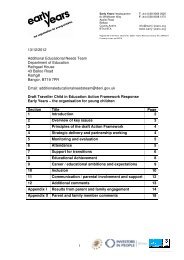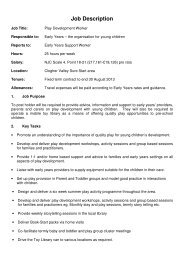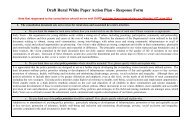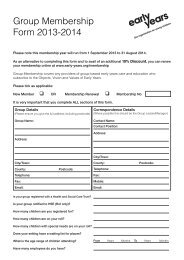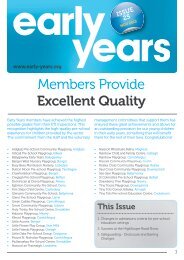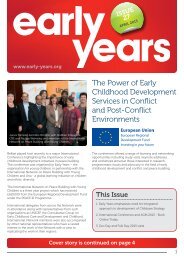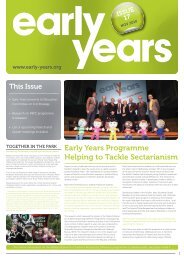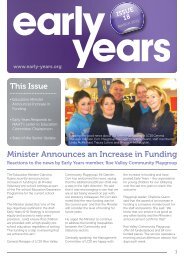Learning from Nine Examples of Peacebuilding Evaluation
Learning from Nine Examples of Peacebuilding Evaluation
Learning from Nine Examples of Peacebuilding Evaluation
Create successful ePaper yourself
Turn your PDF publications into a flip-book with our unique Google optimized e-Paper software.
Key findings <strong>of</strong> the case studies were: practitioners highly valued the training<br />
and ongoing specialist support; parents welcomed the opportunity for their<br />
children to learn about respecting difference; committed leadership within<br />
the setting where the curriculum was delivered was crucial; and integration<br />
<strong>of</strong> the various aspects <strong>of</strong> the project across different settings was important<br />
to successful implementation.<br />
Considerations on the Methodology<br />
Strengths<br />
• While the Evidence Summit was not designed to produce a rigorous peer<br />
review <strong>of</strong> the evaluation methodology, the RCT discussed here appears to<br />
have been carefully constructed and implemented. The methodology included<br />
true randomization, sufficient power, and credible instruments to measure<br />
the change in attitudes among the children.<br />
• The benefit <strong>of</strong> this methodology, according to Early Years, was that it produced<br />
a simple, powerful measure <strong>of</strong> impact, which was important for their<br />
engagement with donors and with skeptics who believed that introducing<br />
these issues to young children would be counterproductive.<br />
• The inclusion <strong>of</strong> the qualitative research broadened the appeal <strong>of</strong> the<br />
research and generated crucial buy-in <strong>from</strong> staff members, parents, and educators.<br />
The results <strong>of</strong> the qualitative research, Early Years reports, were more<br />
important for stakeholders on a day-to-day basis.<br />
25<br />
Challenges and Pitfalls<br />
• The first key challenge was the financial and other costs <strong>of</strong> the RCT. Due<br />
to the disruption caused within the schools and the complexity and cost <strong>of</strong><br />
the research, the evaluation was necessarily a one-<strong>of</strong>f initiative. It was not a<br />
process that could feasibly be repeated at regular intervals to create ongoing<br />
learning. The organization continues to evaluate their programs but now<br />
primarily uses more qualitative, participatory approaches.<br />
• The use <strong>of</strong> external researchers created problems. Early Years had to<br />
balance the demands <strong>of</strong> the research with their own community development<br />
principles and the dynamic nature <strong>of</strong> the projects being assessed. In<br />
addition, the researchers needed to do their own learning <strong>of</strong> the work <strong>of</strong> Early<br />
Years. Finally, Early Years noted that the design limited research capacity<br />
building within the organization.<br />
• Early Years reported that the qualitative research did not capture the richness<br />
<strong>of</strong> the program, nor the full impact, especially with parents. The bulk <strong>of</strong> the<br />
resources for the initiative went to the RCT. The qualitative research was not<br />
given equal emphasis, which may have created some <strong>of</strong> these shortcomings.



